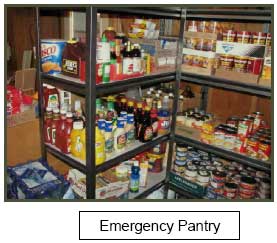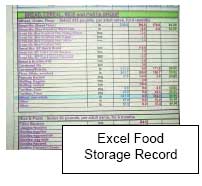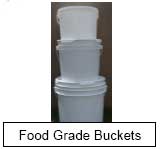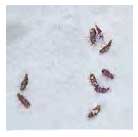Why This is Important
1. Food may not be available as the pandemic progresses. - Grocery stores typically stock three days' worth of food at most. It is on the shelves, not in a warehouse. This just-in-time delivery system works for normal times. When disaster strikes or is imminent (such as a hurricane), the shelves are quickly emptied.
- Re-stocking grocery stores is uncertain during a pandemic or other disruptive emergency. Getting food from the farm to the table is a very complex system. In a flu pandemic, farmers, food processors and truck drivers will get sick too, which means that grocery stores may run out of food.
- Government assistance is unlikely.
2. You reduce your exposure to the flu virus by minimizing your trips away from home.Getting started


What kind of food? Store what you already eat. By doing this, you avoid adding dietary stress to an already stressful situation.

How can I ever do this? Start now, but don't defeat yourself.
Break the task of stockpiling down into stages. Getting your pantry stocked for two weeks is a good initial goal. Simply write down what you eat over a two-week period. Then add a few extra items on each shopping trip. Look for specials and bulk purchases. Remember to add lunches for children who are normally at school, as well as infants and toddlers.
Once you've reached this goal, go for four weeks of food, then eight, and then twelve. In a few months, you will have a full pantry of your kind of food!

For a quick start to your emergency pantry, you can purchase rice, beans, noodles and canned soups to get a family meal stretched pretty far. Put these in metal garbage cans and seal with duct tape. Then add to this basic emergency stockpile using the strategies discussed next. Recipe suggestions: 'Stockpiling Food for Small Spaces and Small Budgets' from the downloads section on the homepage.

 How do I keep track of all this stuff?
How do I keep track of all this stuff? You can use any form to record the food items you need, what you buy on each shopping trip, what you use, and what to re-supply. A tablet works. You can download food inventory spreadsheets from the Internet.
 How do I avoid spoilage?
How do I avoid spoilage? - Rotate your supplies. 'Eat what you store. Store what you eat.' You are building your own pantry for daily use. A shelf-life guide from Kansas State University is at Refrigerated, Frozen and Cupboard Storage Charts
- Use containers that keep things dry and airtight. FREE food grade buckets with lids are often available from the bakery departm
 ent of grocery stores. Just clean, label and date.
ent of grocery stores. Just clean, label and date.
- Storage temperature is important. The cooler the better, to extend shelf life.
How do I control pests? You will want to keep pests OUT of your food. The following suggestions are from the University of California:
Pests of Homes, Structures, People and Pets.

Most home infestations of pantry pests maintain themselves on spills in the crevices of cupboards and drawers or in opened packages of food stored for long periods of time. Following a few general guidelines when storing food products will help you avoid many potential problems.
- Do not put exposed food on shelves. Place it in containers with tightfitting lids (plastic bags are not adequate).
- Regularly clean shelves, bins, and all other locations where there is any possibility of flour or other food particles accumulating. Certain pests need only small amounts of food to live and breed. Soap and water is great for cleaning flat areas, and vacuuming with a crevice attachment will help clean cracks, edges, and corners.
- Do not mix old and new lots of foodstuffs. If the old material is infested, the pest will quickly invade the new.
- Clean old containers before filling them with fresh food. They may be contaminated and cause a new infestation.
- Do not purchase broken or damaged packages of food materials. They are more likely to become infested.
- Construct storage units so that they are tight and can be cleaned easily.
- Store bulk materials, such as pet foods, in containers with tight-fitting lids.
- Keep storage units dry. This is important because moisture favors the development of pantry pests; dryness discourages them.
- Some pantry insects breed in the nests of rodents and insects and may migrate from these into homes. Eliminate any nests found in or near the home.
- Pantry pests can also breed in rodent baits. Be sure to frequently check and discard infested baits.
Small Spaces, Small Budgets
Storing a lot of food in limited space is challenging, but it is being done. An outstanding how-to,
"Stockpiling Food for Small Spaces and Small Budgets," is available at the downloads section on the homepage.